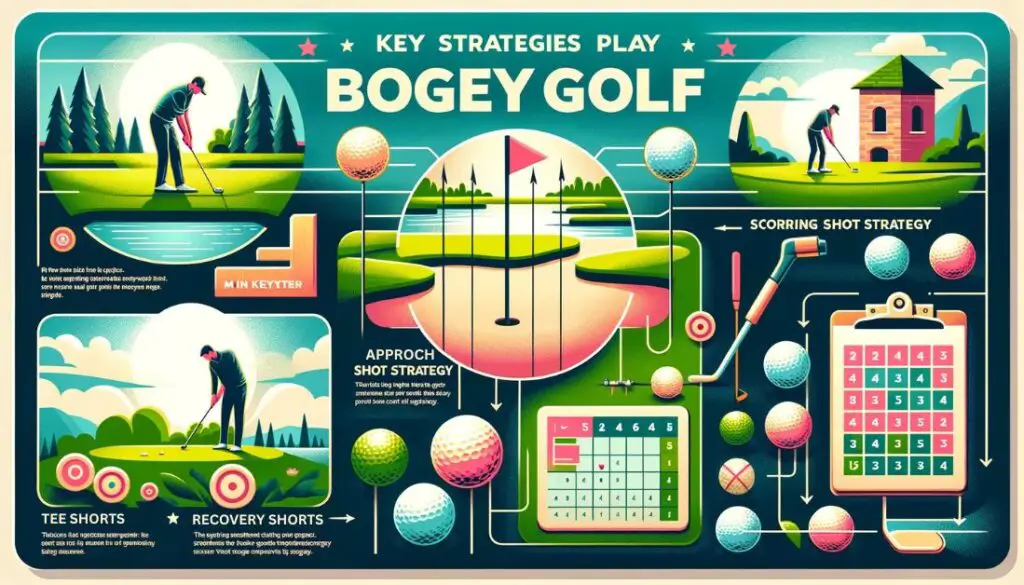A bogey golfer is a term widely used in the world of golf, often referring to players who are working towards achieving a higher level of consistency and competence on the course. In simple terms, a bogey golfer averages one over par on every hole, which means they typically score 5 on a par-4 hole. For many recreational golfers, reaching this level is a significant milestone. It shows steady improvement and marks progress in understanding the game. The roots of bogey golf predate the modern association we have with golf scores, giving us a glimpse into the rich history and evolution of the sport’s terminology.
This is a key milestone for most golfers, as it demonstrates not just an appreciation for the game but a deeper understanding of how the sport has transitioned over time. The formal definition of a bogey golfer is recognized in systems like the USGA Handicap System, where it means scoring 1-over par on an individual hole. This scoring standard is used by many golf enthusiasts to track their performance. For instance, if a golfer is playing a hole with a par rating of 4 and they score 5, they’ve made a bogey.
The origin of the term has a historical context, but in today’s game, it reflects the progress and aspirations of most golfers. It’s a measure of being just shy of par while aiming for that next level of competence and performance. In this article, we’ll explore how to play bogey golf effectively and become a successful bogey golfer. We’ll discuss essential strategies to improve your game and highlight common mistakes to avoid. Finally, we’ll provide some valuable tips to help you play at your best.
Table of Contents
ToggleWhat Is A Bogey Golfer?
Bogey golf, also known as “Par 3 Scoring” or “Best Ball Bogey,” is a fun and casual way to play golf that levels the playing field for golfers of different skill levels. A bogey golfer is a person who typically averages one stroke over par on each hole during a round of golf. Over 18 holes, their total score tends to be around 90 to 96 strokes, depending on their level of play. In generality, bogey golfers fall in the handicap range of mid-teens to high-teens, often classified around 19 or slightly better.
These golfers aren’t hitting long from the tee, and they might struggle to reach the greens in regulation, but they make up for it with a decent short game, especially from 100 yards or less. I’ve seen players with this profile miss a lot of greens but still manage a great game around them. Their average putters and good shots help them balance out those occasional squirrely shots. The reality of a bogey golfer is that they’re shooting to their handicap about 3 out of every 10 times, with an average score usually sitting around 95 to 96 strokes on a par-72 golf course. They might end a round with 9 pars, and often a couple of doubles or worse.
On a really good day, they may shoot as low as 86, but for many, bogey golf is a fair ballpark number. In common usage, most recreational golfers will never break 100, but some of them, with more practice and focus, can get their scores down to the low 90s, sometimes even flirting with 90 or lower. While only a small percentage of amateurs ever score consistently below that, practicing regularly can lead to gradual improvement.
How To Play Bogey Golf?

Playing bogey golf is about staying consistent and making smart decisions on each hole. For bogey golfers, reaching the greens in regulation might not always happen, so you need a great strategy to manage your game. Focus on avoiding the dreaded three-putt and be prepared to layup when your drive lands in the rough. While you may not always hit pars, getting the occasional birdie and minimizing mistakes can lead to a more respectable score. The answer to improving as a bogey golfer lies in practice and playing to your strengths. It’s a solid foundation for any new player with a long future in the game.
Here are some important points know need to know while playing:
- Scoring: Instead of counting strokes like in traditional stroke play, in bogey golf, a bogey on every hole is scored based on whether the player makes a bogey (1 over par), par, or better than par.
- Point System:
- Bogey = 1 point
- Par = 2 points
- Birdie = 3 points
- Eagle = 4 points
- Albatross (double eagle) or better = 5 points
- Playing Format: Bogey golf can be played individually or as a team event (e.g., better ball format or scramble format).
Strategies To Play Bogey Golf And Become A Bogey Golfer

Playing bogey golf and becoming a bogey golfer means averaging one stroke over par, which can be a respectable achievement for many golfers. The key to reaching this level lies in understanding and implementing effective strategies throughout your game. From the tee shot to the putting green, a focus on smart decision-making can help you navigate the course and improve your scores. Here are some essential strategies that can lead you to consistently play at a bogey level.
Tee Shot Strategy
To successfully navigate bogey golf, it’s crucial to have a solid tee shot strategy. Start by understanding where to position the ball to set yourself up for the easiest next shot. On par 3 holes, think about which side of the green gives you the best chance for a par or bogey chance. While aiming for bogey, you might need to plan your approach, especially on the most difficult holes. It’s common to play rounds that include 4 pars, 11 bogeys, two double bogeys, and perhaps even one triple bogey. This blend of scores captures the reality of bogey golf, where the possibilities can vary greatly.
Approach Shot Strategy
When working on your approach shot strategy, avoid aiming for the pin if you’re more than 50 yards away from it. This can worsen results and get you into trouble. Instead, choose a safe shot and evaluate any hazards or obstacles you may encounter.
Scoring Tactics
As you play, focus on your scoring tactics; know which holes are suitable for a bogey and aim for a par where you can. Bad shots will happen, so when they do, reassess your current position and think about whether to chip or pitch back to the fairway.
Recovery Shots Strategy
In situations where you find yourself in trouble, it’s important to have a recovery shots strategy. Instead of trying to save par, aim for a conservative shot that helps you get back on track without taking unnecessary risks.
Putting Strategy
Practicing your putting is also essential. A one putt can be as valuable as a 250-300 yard shot, so make sure to position the ball for the next putt effectively, considering the green slope and speed to eliminate three putts.
Effective Course Management
In my experience, honing your short game has been key to lowering scores. Efficient chipping and precise putting can save you many strokes. Additionally, understanding your skill level and making wise choices about which tees to play can dramatically impact your game. Combining these strategies will enhance your overall performance and help you consistently play bogey golf.
Mental Resilience
Staying calm on the course is also vital. When you face bad holes, maintaining a positive outlook and visualizing successful shots will help you stay on track. Remember, with the right mindset and preparation, playing consistent bogey golf is not only achievable but also rewarding.
Mistakes That Prevent Bogey Golf

Achieving bogey golf is an achievable benchmark for many players, but certain common pitfalls can hinder your progress. Here are some common pitfalls you need to know to know about.
Over-Aggressiveness
One major mistake is being too aggressive. Golfers often go for hero shots instead of choosing safer options, which leads to unnecessary hazards. Playing it safe can prevent big mistakes and keep your score manageable. Instead of trying to force a spectacular shot, focus on making solid, consistent plays that keep you in a good position.
Ignoring Strengths
It’s also crucial not to overlook your strengths. Every player has areas where they excel and others where they struggle. By recognizing and using your strong points, you can create a significant difference in your game. For example, if you’re better at chipping than driving, lean into that skill during your rounds. Another common oversight is neglecting practice in key areas like the short game. The majority of shots are played close to the green, so it’s vital to focus on that part rather than disproportionately focusing on long drives. This focus can make your overall game much stronger.
Poor Course Management
Lastly, having poor course management can add strokes to your score. If you don’t have a solid understanding of the nuances of each hole or misjudge the conditions, you can easily increase your score. Taking time to analyze each hole before you play can help you avoid common traps. Knowing when to take risks and when to play conservatively is key. Keeping these factors in mind will help you avoid pitfalls and achieve your goal of bogey golf.
Tips For Playing A Bogey Golf Like A Pro

Playing bogey golf or becoming a bogey golfer can still feel like a win if you strategize your game correctly. For many golfers, the goal isn’t always to shoot under par but to keep their score around a bogey level. Whether you’re a beginner or a seasoned player, staying consistent and reducing errors can make all the difference. To play a bogey game like a pro, you’ll need to focus on a few key areas: warming up, improving your short game, controlling your putts, and making smart decisions with your club choices. Each of these steps will bring you closer to mastering the course and improving your overall performance.
Warm Up Before Each Round
When you step onto the course, making sure you are properly warmed up is absolutely crucial. A good warm-up isn’t just about better results on the scoreboard; it’s also about preventing an injury that could leave you sidelined for a month or more. Stretching your muscles and getting your body ready can keep you healthy and prepared for whatever challenges the round may throw at you. I’ve learned from personal experience that skipping a warm-up can have serious consequences, and it’s a mistake you only want to make once.
Master Your Short Game
Improving your short game through pitching and chipping can transform your overall results, especially if you’re a high handicap golfer. You won’t always hit the greens in regulation, so getting comfortable with these shots will help you save strokes. Spend extra time practicing your putting drills, focusing on distance control within 10 feet. This is the key to eliminating those dreaded three-putts, which are often the biggest score killers.
Make Smart Decisions On The Course
Sometimes, leaving your driver in the locker room is the best move. If you’re not hitting it well, the shot dispersion can cost you strokes and put you in a bad position for your next shot. Instead, opt for a club that gives you more control, even if it means sacrificing a bit of distance. Keeping the ball in play by aiming for safer spots on the fairway and avoiding water hazards can prevent unnecessary penalties. Remember, it’s better to take an extra stroke than to risk doubling up because of a poor shot.
Read More: What Does It Take To Play Bogey Golf?
Conclusion
As someone who has spent years on the golf course, I’ve realized that the journey of a bogey golfer is both exciting and rewarding. It’s an endeavor where you’re always striving to get better, learning new techniques, and gaining a deeper understanding of the game. In the vast and ever-evolving world of golf, every golfer’s progress is unique. While some aim to reach scratch proficiency, the majority of us spend most days making small improvements, often with a few double bogeys along the way. The process is a constant reminder that there’s always more to learn and explore.
It’s important to remember that improving in golf takes a lot of practice, time, and effort. Results can’t be achieved overnight, but if you continue to put in the work and hone your skills, you’ll surely see 100% results. From following tips in articles like this to developing a personalized strategy, the key is to keep in mind that the process is ongoing. Whether you’re having a great round or a tough day, the lessons learned help you become a better player. Keep playing, because every experience, even the bad ones, adds up to making you a stronger golfer.
You can also check out some extra tips on how to break 90 in another article I wrote—just click HERE.
FAQ's
An 18 handicap golfer is considered a bogey golfer, typically scoring one over par per hole. The course uses a slope and rating system to measure difficulty. A scratch golfer, with a handicap of 0, plays to the rating, while the slope shows the increased level of challenge for an 18 handicap golfer compared to a scratch golfer. This system explains the varying average scores for different courses.
When we look at the numbers, around 14% of male golfers and 15% of female golfers fit into the bogey golfer category. While no golfer hits the same score every round, a typical score for a male bogey golfer usually falls between 93 and 97. This range can vary depending on the par and the difficulty of the course. A couple of strokes can make a difference, but this is where most golfers land within the bogey golfer category.
According to the USGA, a bogey golfer typically has a Handicap Index between 17.5 and 22.4. This golfer can hit tee shots an average of 200 yards, and on a 370 yard hole, they can usually reach the green in two shots. Similar to how a course rating is calculated, the slope of a course is influenced by both the Bogey Yardage Rating and the Bogey Obstacle Rating, which help determine the difficulty for a bogey golfer.



